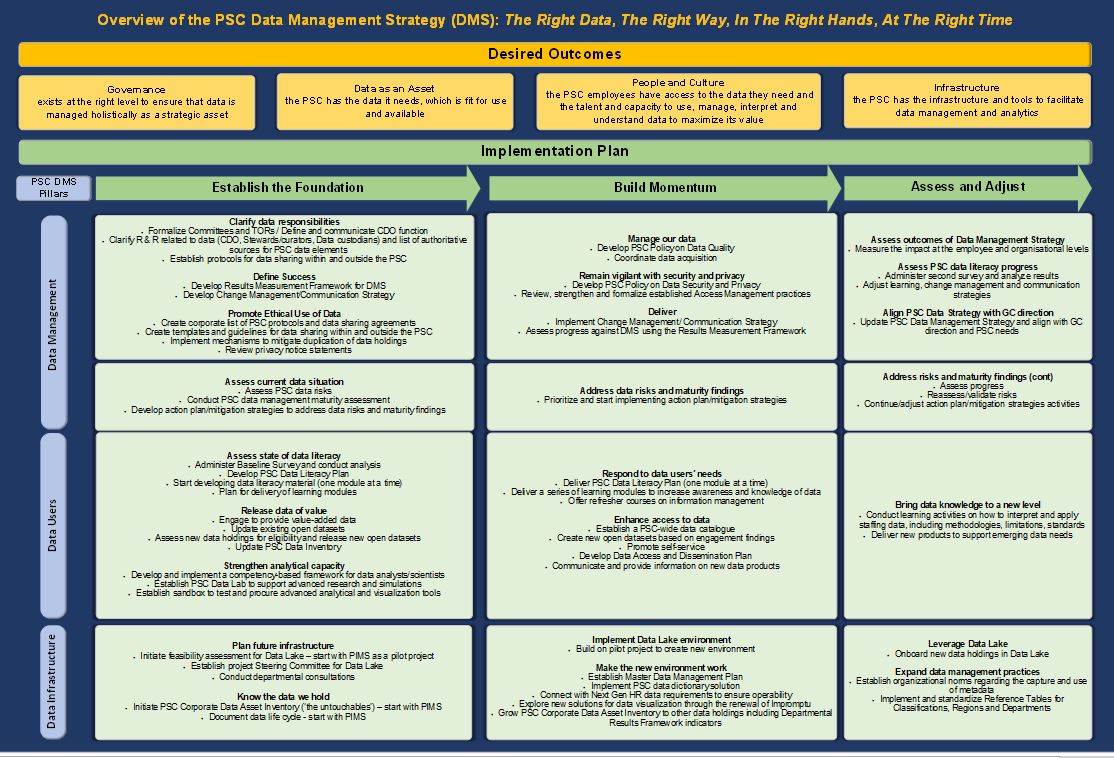Overview of the PSC Data Management Strategy (DMS): The Right Data, The Right Way, In The Right Hands, At The Right Time

Text version
Overview of the PSC Data Management Strategy (DMS): The Right Data, The Right Way, In The Right Hands, At The Right Time
Desired Outcomes:
- Governance: exists at the right level to ensure that data is managed holistically as a strategic asset
- Data as an Asset: the PSC has the data it needs, which is fit for use and available
- People and Culture: the PSC employees have access to the data they need and the talent and capacity to use, manage, interpret and understand data to maximize its value
- Infrastructure: the PSC has the infrastructure and tools to facilitate data management and analytics
Implementation Plan:
PSC DMS First Pillar: Data Management
Establish the Foundation
Clarify data responsibilities
- Formalize Committees and TORs / Define and communicate Chief Data Officer function (CDO)
- Clarify roles and responsibilities related to data (CDO, Stewards/curators, Data custodians) and list of authoritative sources for PSC data elements
- Establish protocols for data sharing within and outside the PSC
Define Success
- Develop Results Measurement Framework for DMS Data management strategy
- Develop Change Management/Communication Strategy
Promote Ethical Use of Data
- Create corporate list of PSC protocols and data sharing agreements
- Create templates and guidelines for data sharing within and outside the PSC
- Implement mechanisms to mitigate duplication of data holdings
- Review privacy notice statements
Assess current data situation
- Assess PSC data risks
- Conduct PSC data management maturity assessment
- Develop action plan/mitigation strategies to address data risks and maturity findings
Build Momentum
Manage our data
- Develop PSC Policy on Data Quality
- Coordinate data acquisition
Remain vigilant with security and privacy
- Develop PSC Policy on Data Security and Privacy
- Review, strengthen and formalize established Access Management practices
Deliver
- Implement Change Management/ Communication Strategy
- Assess progress against DMS using the Results Measurement Framework
Address data risks and maturity findings
Prioritize and start implementing action plan/mitigation strategies
Assess and Adjust
Assess outcomes of Data Management Strategy
- Measure the impact at the employee and organisational levels
Assess PSC data literacy progress
- Administer second survey and analyze results
- Adjust learning, change management and communication strategies
Align PSC Data Strategy with GC direction
- Update PSC Data Management Strategy and align with GC direction and PSC needs
Address risks and maturity findings (cont)
- Assess progress
- Reassess/validate risks
- Continue/adjust action plan/mitigation strategies activities
PSC DMS Second Pillar: Data Users
Establish the foundation
Assess state of data literacy
- Administer Baseline Survey and conduct analysis
- Develop PSC Data Literacy Plan
- Start developing data literacy material (one module at a time)
- Plan for delivery of learning modules
Release data of value
- Engage to provide value-added data
- Update existing open datasets
- Assess new data holdings for eligibility and release new open datasets
- Update PSC Data Inventory
Strengthen analytical capacity
- Develop and implement a competency-based framework for data analysts/scientists
- Establish PSC Data Lab to support advanced research and simulations
- Establish sandbox to test and procure advanced analytical and visualization tools
Build momentum
Respond to data users’ needs
- Deliver PSC Data Literacy Plan (one module at a time)
- Deliver a series of learning modules to increase awareness and knowledge of data
- Offer refresher courses on information management
Enhance access to data
- Establish a PSC-wide data catalogue
- Create new open datasets based on engagement findings
- Promote self-service
- Develop Data Access and Dissemination Plan
- Communicate and provide information on new data products
Assess and Adjust
Bring data knowledge to a new level
- Conduct learning activities on how to interpret and apply staffing data, including methodologies, limitations, standards
- Deliver new products to support emerging data needs
PSC DMS Third Pillar: Data Infrastructure
Establish the foundation
Plan future infrastructure
- Initiate feasibility assessment for Data Lake – start with PIMS as a pilot project
- Establish project Steering Committee for Data Lake
- Conduct departmental consultations
Know the data we hold
- Initiate PSC Corporate Data Asset Inventory (‘the untouchables’) – start with PIMS
- Document data life cycle - start with PIMS
Built Momentum
Implement Data Lake environment
- Build on pilot project to create new environment
Make the new environment work
- Establish Master Data Management Plan
- Implement PSC data dictionary solution
- Connect with Next Gen HR data requirements to ensure operability
- Explore new solutions for data visualization through the renewal of Impromptu
- Grow PSC Corporate Data Asset Inventory to other data holdings including Departmental Results Framework indicators
Assess and Adjust
Leverage Data Lake
- Onboard new data holdings in Data Lake
Expand data management practices
- Establish organizational norms regarding the capture and use of metadata
- Implement and standardize Reference Tables for Classifications, Regions and Departments